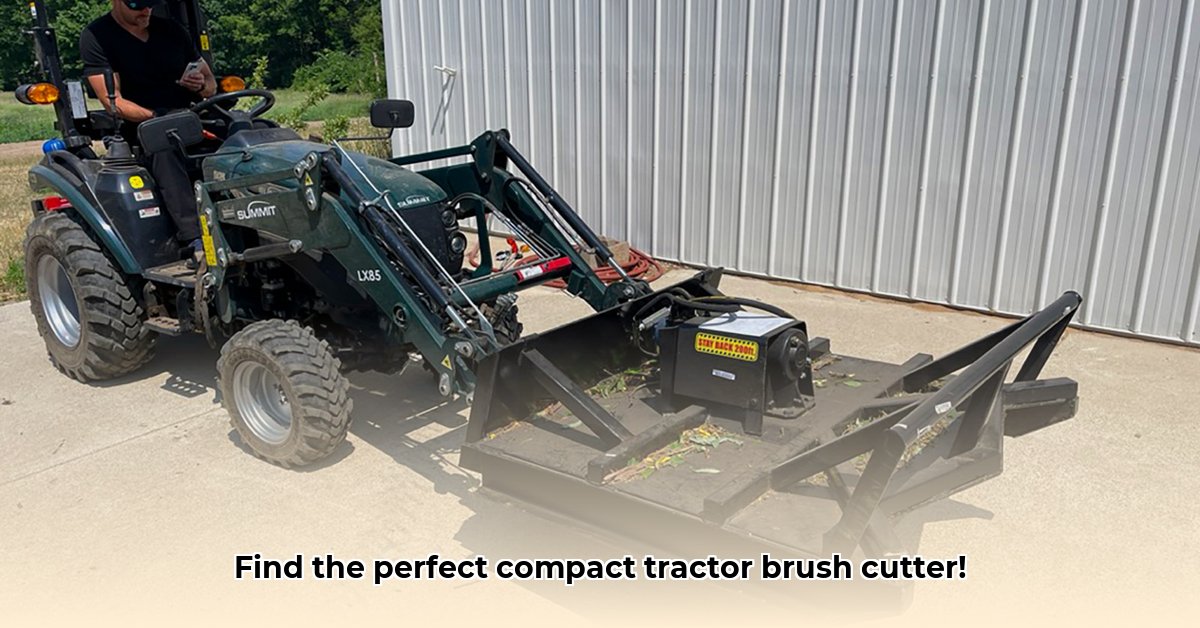
Navigating the Booming Compact Tractor Brush Cutter Market
Clearing land efficiently is crucial for sustainable agriculture and land management. Compact tractor brush cutters offer a powerful solution, but the market's high demand leads to significant lead times—sometimes three to four months! This guide helps you navigate this landscape and choose the best cutter for your needs. Are you prepared for the long wait times but also the significant labor savings? For more information on brush cutter attachments, check out this helpful resource.
This surge in popularity reflects the growing preference for efficient land clearing methods. While customer satisfaction is generally high, reported issues include occasional assembly difficulties and some performance variations depending on vegetation type and the match between tractor horsepower and brush cutter requirements. Understanding these nuances is critical for a successful purchase.
Selecting Your Ideal Compact Tractor Brush Cutter
Purchasing a compact tractor brush cutter is a significant investment. This section provides a structured approach to selecting the optimal model for your specific needs and budget.
Key Factors to Consider
Horsepower Compatibility: Ensure your tractor's horsepower adequately powers the brush cutter. Insufficient power leads to poor performance; excessive power wastes resources. Find the right balance.
Cutting Width: While wider cutting widths increase efficiency, maneuverability in confined spaces decreases. Choose a width appropriate for your typical working areas.
Vegetation Type: Different brush cutters are designed for different types of vegetation. Heavy-duty models handle dense brush, while lighter models suffice for less dense vegetation.
Durability and Reliability: Invest in a robustly built cutter designed for longevity and reliable performance in challenging conditions. A frequently broken cutter will dramatically lengthen the time and expense to finish a project.
Maintenance Requirements: Consider the ease of maintenance—easy access to parts and straightforward procedures minimize downtime and frustration.
Budget: Brush cutters range widely in price. Determine your budget before researching specific models.
Comparing Popular Models: Hardee vs. Everything Attachments
Several brands dominate the market. Hardee's Brush Tiger and Everything Attachments' Xtreme-Duty Brush Cutter frequently receive positive reviews. However, user feedback reveals strengths and weaknesses in each model within various contexts. Thoroughly researching online reviews and comparing specifications is crucial for informed decision-making.
Pre-Purchase Checklist: Ensuring a Smooth Transaction
Before purchasing, follow these steps:
- Thorough Research: Carefully examine the specifications and features of several models.
- Direct Comparison: Don't focus solely on price. Compare cutting width, horsepower requirements, durability, and warranty terms.
- Warranty Examination: A comprehensive warranty indicates manufacturer confidence. Review terms carefully.
- Lead Time Confirmation: Inquire about delivery times to manage expectations.
- Independent Verification: Verify manufacturer claims through independent reviews and research.
Assembly, Installation, and Ongoing Maintenance: Maximizing Lifespan
Assembly and Installation
While generally positive, some users report receiving incomplete orders. Carefully inspect your shipment upon arrival. Adhere precisely to the manufacturer's instructions for both assembly and installation. Improper installation compromises safety and performance. Contact the supplier immediately for assistance with any difficulties.
Operation and Maintenance for Optimal Performance and Longevity
Prioritize Safety: Always wear appropriate protective gear (eye protection, ear protection, sturdy gloves). Follow manufacturer safety guidelines meticulously.
Regular Inspections: Regularly inspect the cutter for wear or damage. Address issues promptly.
Consistent Lubrication: Keep moving parts well-lubricated to minimize friction and extend lifespan.
Blade Sharpening: Regularly sharpen blades for optimal cutting performance. Dull blades reduce efficiency and increase power consumption.
Proper Storage: Store the cutter properly to protect it from the elements and prevent damage when it's not in use.
Cost-Benefit Analysis: Return on Investment (ROI)
The initial investment in a compact tractor brush cutter can be substantial, but the long-term labor cost savings can be significant, especially for large areas. ROI depends on factors like your hourly labor rate, area to clear, and usage frequency.
(Note: The following cost estimates are approximations and may vary depending on multiple factors.)
| Model | Estimated Initial Cost | Potential Annual Labor Savings | Estimated ROI (Years) |
|---|---|---|---|
| Hardee Brush Tiger | $3,000 - $5,000 | $1,000 - $2,000 | 1.5 - 5 |
| Everything Attachments | $2,500 - $4,500 | $800 - $1,500 | 2 - 5 |
Addressing Potential Risks and Mitigation Strategies
While the benefits are considerable, potential challenges include:
Long Lead Times: High demand results in extended delivery times. Order well in advance of your needs.
Product Defects: Thorough inspection upon delivery is crucial.
Equipment Damage: Improper use or inadequate maintenance can damage the cutter. Follow manufacturer instructions and invest in proper training.
Conclusion: Realizing the Benefits of Compact Tractor Brush Cutters
Choosing a compact tractor brush cutter requires careful planning and comprehensive research. Understanding your needs, budget, and potential labor cost savings is essential. Thorough research and adherence to maintenance schedules maximize your investment and ensure the safe and efficient operation of your equipment for years to come.